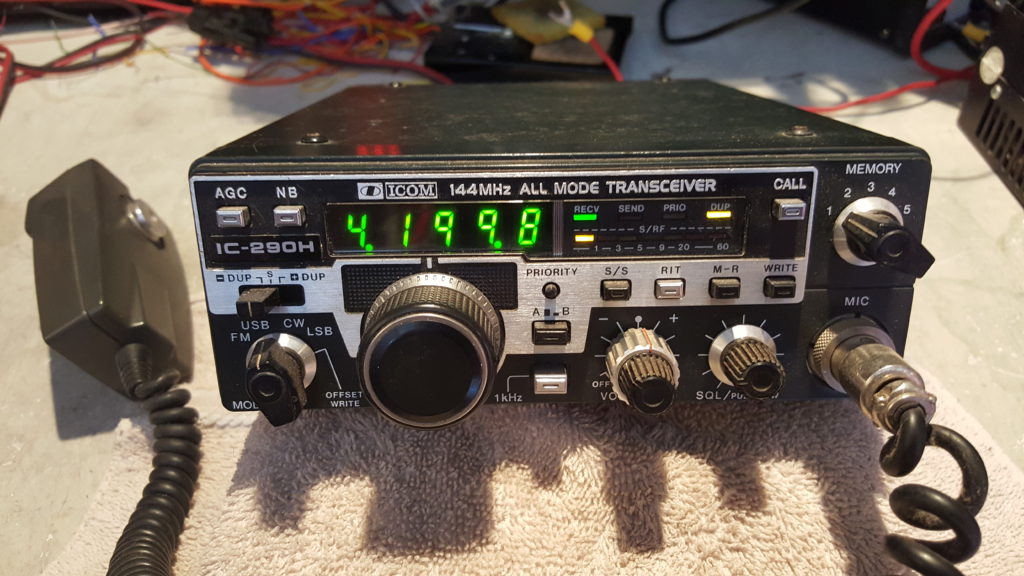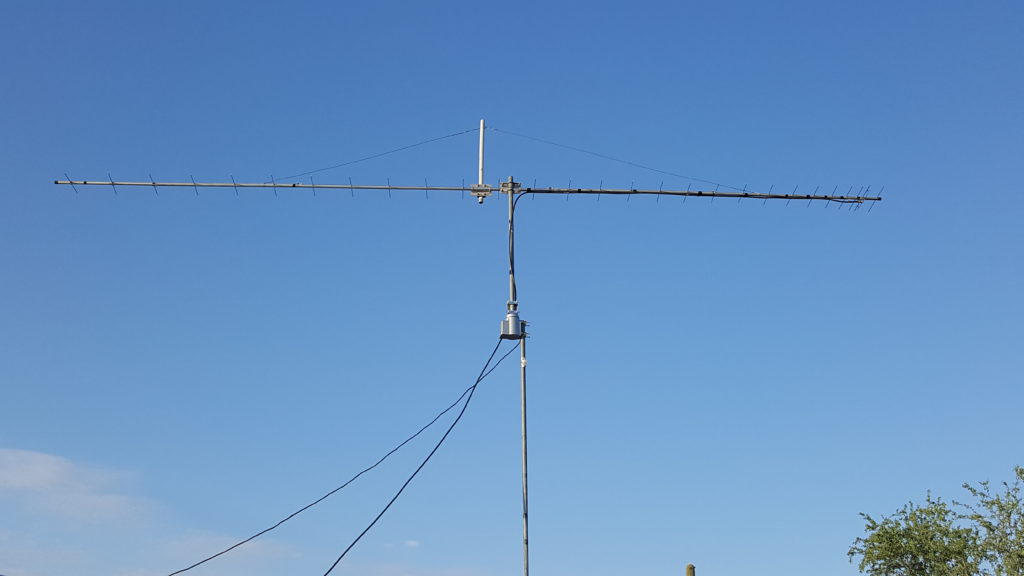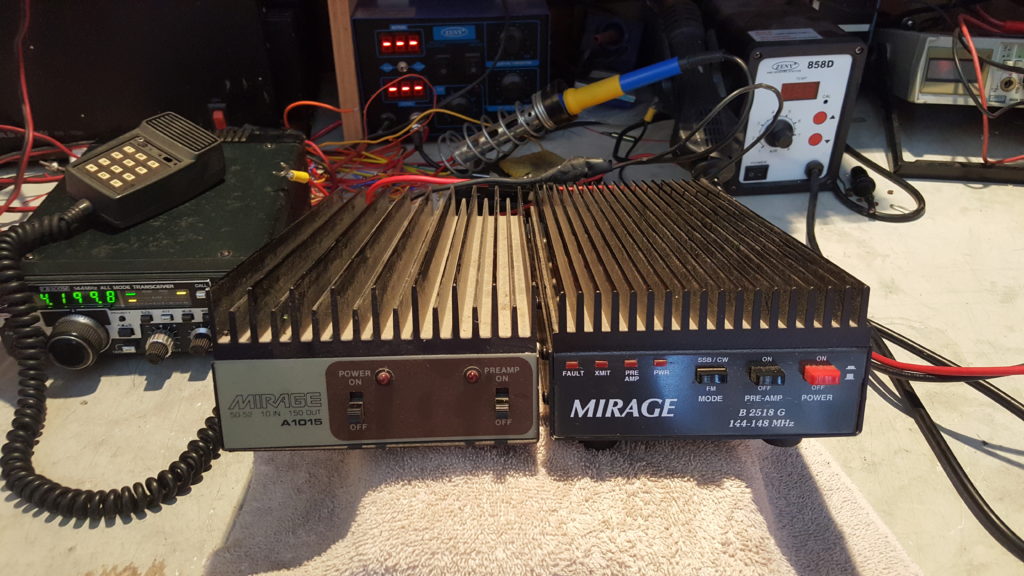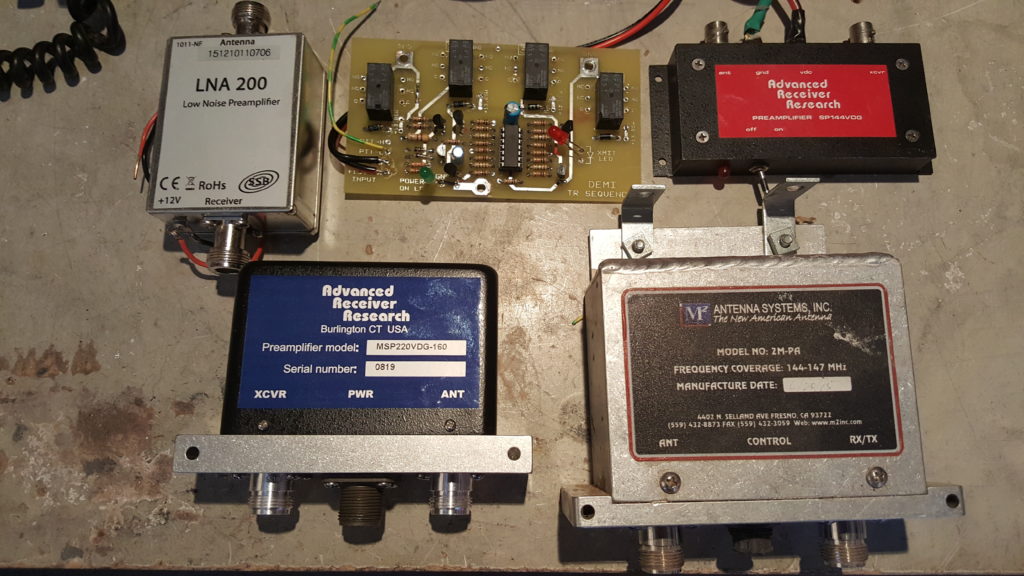One of the great things about ham radio is that you can get started with a modest station without a big investment. Probably the best way to pick up gear for the VHF and higher bands is by attending one of the numerous “hamfest” swap meets that are held nearly year round here in Arizona. There are usually always antennas and radios available for reasonable prices. All of the major amateur radio manufacturers include one or two of the upper bands like 6 and 2 meters, (50 and 144 MHz), on some of their models. Some even have 70cm, (432 MHz). 6m, 2m and 70cm are the most popular bands here in Arizona, followed by 23cm (1296 MHz) and 222 MHz.

Almost all terrestrial weak signal operation on 50 MHz and up uses antennas that are horizontally polarized. It is best to use a rotatable beam antenna that concentrates the energy of your signal in a single direction instead of spreading it in all directions. This also helps your reception of weaker signals from the area the antenna is aimed. Many of these beam antennas are fairly small and can be rotated with a simple TV rotor.

If you are just starting you don’t need an expensive HAM-4 rotor! You can get started with something much “lighter” duty, or even use the “arm-strong” method and turn it by hand. With a transmit power of 25 watts and a 6 or 7 element antenna on 144 MHz, regular communication of 100 miles or more is possible. That is Phoenix to Tucson and beyond – simplex – without repeaters! Much larger distances are possible on 6 meters where low power signals can travel thousands of miles during the main summer season, even with a homebrew wire antenna! More on this later.
Once you have your rig and antenna set up you can call into the various 50 to 1296 MHz nets and round table groups here in Arizona (link coming soon!) where you will find a bunch of people quite happy to answer questions or just shoot the breeze! Above all, ASK QUESTIONS! Use the chat room to get things started.
Amplifier
This is probably the first piece of gear most hams upgrade their stations with. Having a power output in the 100 watt or higher level significantly increases your range and ultimately your success/enjoyment on these bands. The bigger stations will run up to the 1500 watt limit but you don’t need anywhere near that power to be able to work most of the modes described before. Small amplifiers up to 150 watts can be found at hamfests for maybe a dollar per watt. Some even include a “pre-amp” (more on that below.)

EBAY can be a source as well, but be prepared to do some repair. Many of these have bad power transistors or relay issues. Use the chat room for advice!
Low Noise Amplifiers (LNA) or “pre-amps”
Just as the amplifier above increases your outbound signal, the LNA boosts the received ones. These are sensitive devices that need to be automatically switched away from the coax line to the antenna when transmitting.

Many of them do this automatically at low power levels. The beat place to use an LNA is up at the antenna, but in the beginning it is far easier and only slightly less efficient to just put it in the coax line from the radio to the amplifier. Some amps have a OK pre-amp in them you can use to get started.
Sequencer
This device is usually a small circuit board or box containing one that acts like a switch to isolate sensitive equipment when you transmit. They do this task in a timed series of events that happen a few milliseconds apart upon transmitting, then turning off in reverse sequence when you go back to receive. There are usually up to 4 events that can be configured. This device protects your amplifier and LNA from being accidentally damaged. These are usually only needed in a more advanced setup.
Transverter
These small units are interfaced to a transceiver for the purpose of adding a new band. They take advantage of circuits your transceiver already has so it can save money. They are a bit more complicated to set up, usually requiring the use of a sequencer and amplifier.
Digital interface
A digital interface is a device that interfaces your computer to the radio for digital communication. The best ones have their own soundboard. The most popular ones used are the Rig Blaster series from West Mountain Radio, or the SIGNALINK by Tigertronics, many of the new radios including products from Icom and Yaesu now have digital devices included in the radios!
Coax or hardline
You may not think of the wire connecting your rig to the antenna as equipment, but you should. The wrong type of coax, (RG58, RG8, Mini8, etc), will eat up much of your hard earned signal before it reaches the antenna. The same is true on receive as well. A good type of coax to start with is LMR400. Times Microwave makes a quality product. For more advanced applications heliax or “hardline” is used. This type of coax is more expensive but eats up much less signal, especially on the bands from 432 MHz and up. N type connectors should be used where possible as they are more waterproof and efficient than the PL-259 style.
Other stuff
A good watt meter is a must have. One that covers the VHF/UHF frequencies specifically is needed for accuracy. Bird 43 meters are the “industry standard” and most common. Here is a video on their use. Antenna analyzers that cover these frequencies are nice, but one can usually be borrowed if you are adjusting a new antenna. There is no substitute for a well adjusted antenna! Look for local hams in your area to see what they are using for analyzers. It can take a while to tune some antennas, but the time and effort is worth it! Invest in a good comfortable pair of noise cancelling headphones. Many signals on VHF are very weak and it sure helps to have a good set of headphones.
